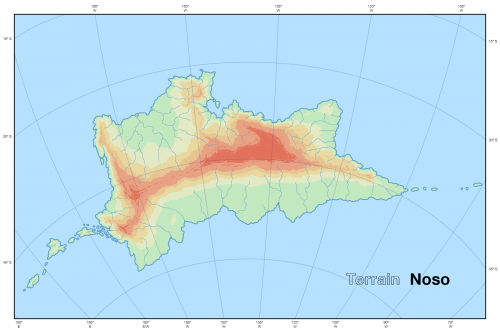Noso
Noso is one of the four continents on Novo. It is flanked by the Khattak island arc on the west and the Atlingi island arc on the east. Noso was first peopled some 45000 years ago from Atchilja via the Khattak island arc. Slowly, their descendants would disperse across the continent, and eventually reach D'ekaš via Atlingi.
Iša, a plant not unlike quinoa, is the primary grain grown throughout the continent. Its first domestication likely occurred somewhere in the Northwestern plain, from where it spread both further west up to the the furthest extant of the Nosoan side of the Khattak island ark, and eastwards to the far point of the continent. On the east coast, iša is heavily supplemented by 'e'la, where a common cross-cultural staple meal is a porridge consisting of equal parts iša and 'e'la. The spread of iša as a staple crop is associated with the wide distribution of Northwestern languages, particularly in the northwestern part of the continent, hence the family's name. Penetration of agricultural practices is poor in the southern half of the continent, where inhabitants have maintained their hunter gatherer lifestyles for several millennia, largely undisturbed by their northern neighbours.
History
The first states on Noso arose somewhat concurrently with the late-classical age on D'ekaš. This first occurred along the coast of the Iṅlyazi bay, where increasing levels of urbanization and social stratification ultimately resulted in the idea of the ɔṅkiṅ. This was a king who's right to rule derived from their 'innate superiority' over their fellow man, and was reflective of a highly delineated caste system that developed in the region. The idea of the ɔṅkiṅ spread eastward, and came to be the default assumption about leaders from the Iṅlyazi bay eastwards, however the caste system was not as strong or prevalent the further from the Iṅlyazi bay one goes. Somewhat concurrently, statehood arose independently in the west, where urban sites developed into an archipelago of city states, particularly in the region surrounding the terminal end of the Khattak arc and the islands there. Colonization by these states of their northern coast resulted a network of cities connected through both war and commerce. This was the Uhajja civilization. The ɔṅkiṅ system resulted in the formation of territorial states that contrasted with the city-states of the Uhajja.
Inevitably, contact and trade would occur between these two regions. As such, both to control the increasing commerce in the region, and to respond to threats from east and west, the coastal regions of the Northeastern plain (already living in small urban settlements) began to collate into loose confederacies. These confederacies were liquid in nature and coalesced and dissipated frequently, however they were able to effectively prevent incursions of Iṅlyazi armies over the centuries. Over the centuries, these confederacies would become more organized, culminating in the region becoming dominated by Ezenâ in the east and Ânkovara in the west.
Old
A note on my old thoughts. It was previously my intention to leave Noso unpopulated by 'civilizations', and to critically examine colonialism and whether an alternative to the destructive, imperial, irrespective, extractive, and not-infrequently genocidal practices that were seen on Earth could be performed here. The latter is still possible, however I have abandoned the former -- not because I think it is impossible or unlikely that technology has progressed to the point of 'civilizational development' but rather that I felt to do so would not be interesting in the framework of the latter and somewhat problematic.,
Though the continent has had a human presence for 45000 years, no large scale urban sites ever developed on Noso. Instead, its indigenous populace practiced their hunter gatherer, and subsistence agricultural lifestyles for the many millennia until explorers from D'ekaš brought irrigated agriculture and urbanized sites with them.
Disturbingly, the lack of civilization or any major urbanized sites prior to the arrival and colonization of Noso by the nations of D'ekaš has resulted in many early intellectuals believing in the inferiority of Noso aborigines. This is a theory that is violently disagreed with and wholly rejected in the modern age.
